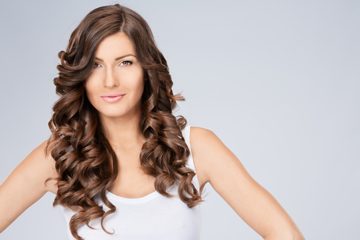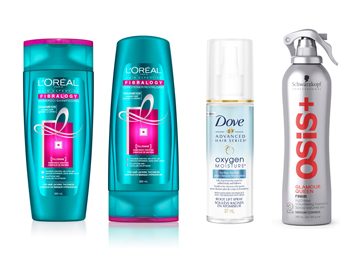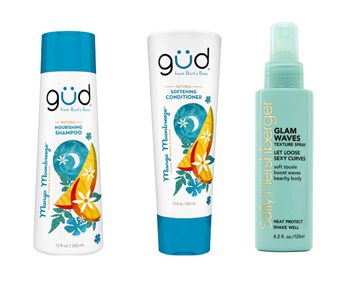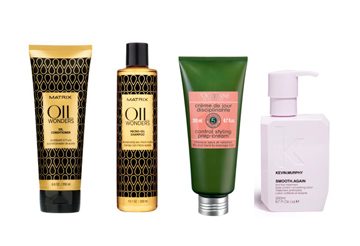
Learn to love your hair texture
There’s nothing more fun than hair nostalgia on social media – a #TBT of a grade school mullet, a perm at prom or that time in college you thought cutting your own bangs was a great idea (been there!) are all bait for scores of likes. But when you chart your hairstyle highs and lows, you want the bad hair days to be firmly in the past.
That said, many of us are still learning to deal with our hair texture, whether it’s fine, wavy or curly. And in that process, we can be our hair’s own worst enemy – from brushing and crunching to overstyling and using the wrong products.
Sometimes, we just need to go back to the basics and relearn how to make the most of what we’ve got. This is one of those times. So, we polled some real women and asked them to weigh in on their hair woes, then enlisted the pros for their best hairstyling tips.

If your hair type is fine
Fine hair breaks more easily, often falls flat and can be flyaway. Take Patti from P.E.I: “Fine hair is good because it doesn’t take long to dry but frustrating because I wish I had beachy waves! Even with product and a curling iron, my waves are flat within minutes,” she says of her baby-fine hair.
Pumping up the volume doesn’t have to be a battle. The right haircut goes a long way to help hold style and volume. “A blunt cut makes hair seem fuller,” says Alex Chabot, artistic director for Matrix Canada. “Or try a heavy, blunt fringe or a side bang that starts back at the crown because the hair will look thicker – basically you want fewer layers as the fullness of ends makes it look fuller.”
In the shower, volumizing shampoo that doesn’t leave residue is your BFF (look for the words “thickening” or “plumping” on the label) and perhaps the most important thing for fine-hair girls: Placement of conditioner is key. “If you use a cream conditioner, massage it only at mid-length and on the ends to detangle, and rinse it really, really well,” says Chabot. “Or if you skip conditioner in the shower, follow with a leave-in treatment spray since fine hair is prone to tangling – it makes hair more manageable.”
“Fine hair definitely needs a great volumizer,” says Clariss Rubenstein, a hairstylist for The Wall Group in Los Angeles. Her celebrity clients include Mindy Kaling and January Jones. “I like sprays, as they do the trick without leaving hair stiff or sticky. Avoid any heavy oils or creams.”
Before you blow-dry, flip hair upside down and spritz a root booster close to the scalp to raise up your roots. Steer clear of waxes and pastes – while they give great hold, they’re too much for fine hair. “A common mistake is using too much pomade or cream – it gives hair too much texture and makes it heavy,” says Chabot.
For blow-drying, a round brush is the go-to tool. “With a round brush, the bigger the brush, the bigger the volume. If you want more curl or texture, use a small-barrel brush,” says Chabot. “A ceramic, carbon or tourmaline brush is preferable to a metallic brush, as its technology distributes the heat more evenly in the hair for longer-lasting hold – a metallic brush heats up too fast.”
Try: L’Oréal Paris Fibralogy Thickness Creation Shampoo, $6; L’Oréal Paris Fibralogy Thickness Creation Conditioner, $6; Dove Oxygen Moisture Root Lift Spray For Fine, Flat Hair, $8; Schwarzkopf Osis+ Glamour Queen Finish H2O-Free Volumizing Hairspray, $20

If your hair type is wavy
A common challenge with wavy hair is getting the waves to be consistent. “Sometimes, I want to wave goodbye to my wavy hair,” says Sue from Ottawa. “It’s hard to get it either straight or super-curly – it’s this awkward middle ground.”
So what’s the difference between wavy and curly anyway? “The biggest difference is that curly hair is often unruly and has a mind of its own, whereas waves will behave – they just need to be enhanced to look their best,” says Rubenstein.
In the shower, look for products that will nourish hair, so it’s shiny, but aren’t laden with tons of butters or oils that might weigh waves down.
To get that perfect rumpling from root to tip, air-drying is your best bet. “For wavy hair, I would use something to tame the frizz and let the waves do their thing,” says Rubenstein. “Avoid anything that makes your hair stiff or crunchy. Waves should look touchable.” Run a texturizing cream through your hands and distribute evenly in the hair, then shape with your fingers. “A wavy look is more natural – think of the beach,” says Chabot. You can also try a wave-enhancing spray all over and let your waves air-dry or use a diffuser.
Once waves have air-dried as much as possible, use a styling iron to touch up your waves. A flat iron that doubles as a styling iron is your best bet here, as it will bend and kink the hair rather than produce giant ringlets, as a traditional curling iron does.
Try: GÜD Natural Nourishing Shampoo, $8; GÜD Natural Softening Conditioner, $8; Sally Hershberger Glam Waves Texture Spray, $13

If your hair type is curly
The most common challenge for curly hair is dryness. Battling coils of curls is futile – it often results in curls that are unruly, frizzy or prone to breakage. “It’s trial and error, but I’ve learned not to fight the curls – I embrace them,” says Jessica from Toronto. “Curl creams enhance curls and help with frizz.” As for the best cut? You want to avoid anything that’s too short. “I love when curly hair is long and layered – there’s something so wild and beautiful about it,” says Rubenstein.
In the shower, curly hair generally needs moisture, so look for curly-hair or super-hydrating formulas. Use a wide-toothed comb in the shower to comb the conditioner through your hair from roots to ends to ensure that every strand is coated. Argan and coconut oils, as well as ingredients like shea butter, will work wonders to condition your curls.
After you step out of the shower, soak up excess moisture with a cotton T-shirt. “The little nubs on a terry cloth towel can disrupt and stick to curls, making them frizzy,” says Mandy MacFadden, hairstylist and Pure Artist for Pureology Canada. “I recommend using a cotton T-shirt instead, as it gets rid of moisture without creating frizz.”
When it comes to styling, you want curls to have spring and be crunch-free, so look for a conditioning cream that will soften and define locks. “I always tell my clients to start applying product underneath, near the nape of the neck,” says MacFadden. “This is an area that needs extra attention since curls are easily disrupted from shirt and coat collars and can get frizzy fast,” she adds.
Rubenstein is also a fan of creams. “I usually combine an oil with a curl-enhancing cream. The cream helps control and shape the hair, and the oil helps with frizz and dryness. Avoid anything that makes the hair stiff or crunchy. Curly hair should look soft!”
A diffuser will help coax the perfect curls. After applying product, use your diffuser, section by section, without moving it. “The diffuser should sit right at the scalp. Hold it in place until hair is dry to secure the curls,” says Chabot.
Try: Matrix Oil Wonders Oil Conditioner, $15; Matrix Oil Wonders Micro Oil Shampoo, $15; L’Occitane Control Styling Prep-Cream, $34; Kevin.Murphy Smooth.Again Anti-Frizz Treatment Style Control Smoothing Lotion, $32
